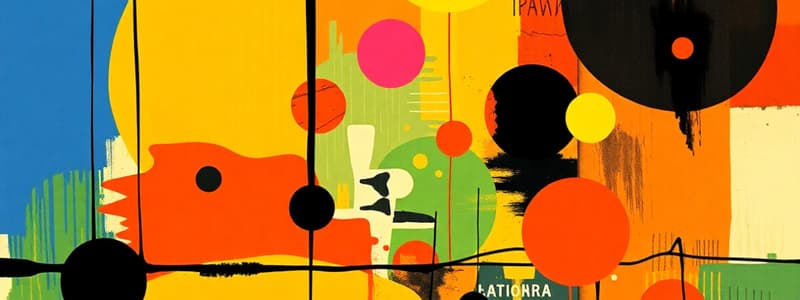Podcast
Questions and Answers
What is the main purpose of causal research?
What is the main purpose of causal research?
- To perform historical analysis of marketing trends.
- To identify predictors of future events and their relationships. (correct)
- To survey large populations for descriptive analysis.
- To collect qualitative data to understand consumer behavior.
In an experiment, which of the following correctly identifies the independent variable?
In an experiment, which of the following correctly identifies the independent variable?
- The observed changes in the production output.
- The results measured after the experiment concludes.
- The demographic information of the participants.
- The treatment or condition being manipulated. (correct)
Which term best describes the relationship where a change in one variable is associated with a change in another variable?
Which term best describes the relationship where a change in one variable is associated with a change in another variable?
- Regression
- Correlation (correct)
- Causation
- Interaction
What condition must be met to establish temporal precedence in experimental design?
What condition must be met to establish temporal precedence in experimental design?
What is random assignment in experimental design intended to achieve?
What is random assignment in experimental design intended to achieve?
Which of the following scenarios best illustrates the concept of correlation without causation?
Which of the following scenarios best illustrates the concept of correlation without causation?
In the context of causal research, what does the dependent variable represent?
In the context of causal research, what does the dependent variable represent?
Which combination of conditions is considered necessary to establish a causal relationship in an experiment?
Which combination of conditions is considered necessary to establish a causal relationship in an experiment?
Which of the following is necessary to suggest that a discount caused an increase in sales?
Which of the following is necessary to suggest that a discount caused an increase in sales?
What does the post hoc fallacy highlight in the context of causal relationships?
What does the post hoc fallacy highlight in the context of causal relationships?
Which statement correctly differentiates between independent and dependent variables in the context of a discount affecting sales?
Which statement correctly differentiates between independent and dependent variables in the context of a discount affecting sales?
What is the primary purpose of conducting a random assignment in experimental design?
What is the primary purpose of conducting a random assignment in experimental design?
What limitation does a quasi-experiment address when random assignment is not feasible?
What limitation does a quasi-experiment address when random assignment is not feasible?
Which of the following demonstrates a common misunderstanding regarding correlation and causation?
Which of the following demonstrates a common misunderstanding regarding correlation and causation?
Why is it important to rule out alternative reasons when assessing the impact of discounts on sales?
Why is it important to rule out alternative reasons when assessing the impact of discounts on sales?
Which statement accurately reflects the relationship between correlation and causation?
Which statement accurately reflects the relationship between correlation and causation?
What is the purpose of causal research as illustrated by the ketchup experiment?
What is the purpose of causal research as illustrated by the ketchup experiment?
In the ketchup consumption experiment, which of the following correctly identifies the independent and dependent variables?
In the ketchup consumption experiment, which of the following correctly identifies the independent and dependent variables?
How can we differentiate between correlation and causation in the context of the animal poster donation study?
How can we differentiate between correlation and causation in the context of the animal poster donation study?
What role does temporal precedence play in establishing a causal relationship in the ketchup experiment?
What role does temporal precedence play in establishing a causal relationship in the ketchup experiment?
Which aspect of experimental design is compromised when using a quasi-experiment for studying study hours at GU and UW?
Which aspect of experimental design is compromised when using a quasi-experiment for studying study hours at GU and UW?
Flashcards are hidden until you start studying
Study Notes
Quasi-Experiments
- A quasi-experiment allows researchers to study cause-and-effect relationships when random assignment isn't possible.
- It relaxes the random assignment requirement, but still satisfies temporal precedence and correlation.
- Example: A study comparing study hours of students at GU and UW.
Causal Research - Example 1
- Research question: Does ketchup color influence consumption?
- Hypothesis: Blue ketchup leads to less consumption than red ketchup.
- Independent variable (treatment): Ketchup color (blue vs. red)
- Dependent variable (outcome): Ketchup consumption
- Correlation: Changes in ketchup color should be linked to changes in consumption.
- Temporal precedence: Participants are given ketchup before recording consumption.
- Random assignment: Participants are randomly assigned to red or blue ketchup.
- This research can be conducted as a true experiment.
Causal Research - Example 2
- Research question: Does the animal displayed on a poster influence donation amounts?
- Hypothesis: Cat posters lead to higher donations than dog posters.
- Independent variable (treatment): Animal on poster (cat vs. dog)
- Dependent variable (outcome): Amount donated
- Correlation: Changes in animal displayed should be linked to changes in donation amounts.
- Temporal precedence: Participants see the poster before making donations.
- Random assignment: Participants are randomly assigned to see the cat or dog poster.
- This research can be conducted as a true experiment.
Experiment Requirements
- Correlation: Changes in the independent variable should be linked to changes in the dependent variable.
- Temporal precedence: The independent variable should occur before the dependent variable.
- Random assignment: Participants should be randomly assigned to different treatment groups to control for potential confounding factors.
Caveats of Correlation
- Correlation alone does not prove causation.
- There might be other factors influencing the observed correlation.
- Temporal precedence is also necessary to establish causation.
Caveats of Temporal Precedence
- Just because one event happened before another doesn't mean it caused it.
- Other confounding factors could have influenced the outcome.
- Random assignment is needed to rule out these alternative explanations.
Caveats of Random Assignment
- Small sample size can lead to bias.
- Practical and ethical considerations can make random assignment difficult or impossible.
- In such cases, quasi-experiments can be used.
Studying That Suits You
Use AI to generate personalized quizzes and flashcards to suit your learning preferences.




